Long-range shooting can be an equipment race. Sometimes, the better equipment decides the outcome of a match or bragging rights at the local range. We wanted to see if we could get into the game with a less-expensive rifle designed for long-distance shooting, the Savage Axis II Precision Rifle, $999, versus pricier models from Mossberg and Ruger, the MVP Precision Rifle, $1500, and the Custom Shop Precision Rifle, $2419, respectively. The Ruger Custom Shop Precision Rifle was in fact designed for the Precision Rifle Shooting Production Division, which has a maximum price point on rifles and optics to ensure competitors are more or less on the same playing field. It’s not a low-budget rifle by any means, but it is a good benchmark for what experienced shooters might want in a long-range production rifle.
As such, we assumed the Ruger would be tricked out for competition more than the Mossberg and Savage, but we wanted to determine if the extra cost and bells and whistles determined how accurate the rifles could shoot. After all, accuracy is where the rubber meets the road, or in this case, where the copper hits the steel. All the bells and whistles we found make it easier for the shooter to place an accurate hit. Features like a barrier stop, or a flat bottom handguard, muzzle brake and others allow a shooter to either set up steadier for a shot or allow shooters to see their hits or misses.
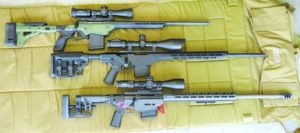
Optics, too, are a big consideration, and the rule is to spend as much on a scope as you would a rifle. We didn’t follow that adage because we were trying to be frugal with our long-range rifle build. We tried three different scopes we had in the shop, a Primary Arms GLx 4-16x50mm FFP scope ($750; PrimaryArms.com) with an illuminated ACSS-Apollo-6.5CR/.224V reticle; a Riton RT-S Mod 5 GEN 2 3-9x40mm scope ($340; KenziesOptics.com) with a SFP Dulex reticle; and a UTG 4-16x44mm scope ($199; Leapers.com) with an SFP 36-color Mil-dot reticle.
If long-range shooting is a game you’re considering, then we wouldn’t hesitate to purchase the Primary Arms scope. We feel the Riton is best suited for hunting situations, but it kept up with the long-range reticles in the UTG and PA. The UTG is inexpensive and a good choice if you are just getting started. We bore-sighted the rifles prior to range work.
In our experience, you don’t need a high-price ultra-tuned rifle to hit a target at distance. The smaller the target, however, and the smaller the group is when a more expensive rifle comes into play. What is mandatory for long-range shooting is a consistent rifle, ammo, and optic. You need to know where the rifle will hit. You also need to be prepared to fire the rifle from prone, sitting, kneeling, standing, and using whatever rest is available.
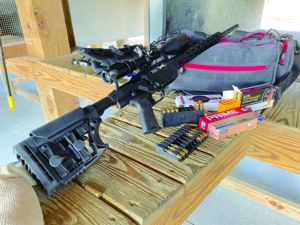
The barrel is the thing with long-range shooting, and the better the barrel, the better the results. The Ruger has a spectacular barrel, while the Savage barrel is excellent, and Mossberg barrel is very good. A rifle that is comfortable to shoot makes it easier for the shooter, so adjustable stocks and pistol-grip angles are important. All three of these rifles have adjustable stocks — length of pull and cheek riser, which are the minimum needed. The pistol grips are all AR-15 styles, so swapping out a grip to suit your needs is simple. We liked the Ruger’s and Mossberg’s Magpul grips because they had more of a vertical angle, which makes shooting prone more comfortable. The ability for the rifle to be set up for whatever shooting situation the terrain provides is important. For instance, all three rifles have M-Lok rails for attaching a bipod, the magazine wells are flared so you can brace them against a barrier and not worry about putting pressure on the magazine, which could cause feeding issues, and the bottom of the rails are flat so the rifle steadies easier when using a rest.
Our rifles were chambered in 6.5 Creedmoor, a popular round for long-range shooting that offers a flat trajectory, great ballistic coefficient, and minimal recoil. It’s accurate, too. Ammo used consisted of Hornady Match with a 140-grain Extremely Low Drag (ELD) Match bullets, SIG Sauer’s Elite Performance loaded with a 140-grain Open-Type Match bullets, and Prime brand cartridges loaded with a 130-grain hollowpoint boat-tail bullets. All of this ammo is capable of shooting one ragged hole at 100 yards.
How We Tested
We did not break the barrels in. We shot multiple strings and allowed the barrels to cool for a few minutes after each string. We were not patient with any of the rifles because we wanted to know if the barrel would retain accuracy after heating up. The first string was five shots at 50 yards with each ammo brand to get our dope. Next was another five-shot string with each ammo brand to tweak the zero at 100 yards, and then another three-shot string at 100 yards and 200 yards for accuracy. The temperature was 68 degrees with 10-mph wind speed. At 100 to 200 yards, wind speed was not much of a factor during our test. At farther distances, 10-mph wind would have us compensating for the drift. We used Thompson Targets HALO Scope Alignment Targets ($15/10; ThompsonTarget.com) with a 1-inch grid. These targets burst a halo around the bullet hole on impact, making it easy to see hits.
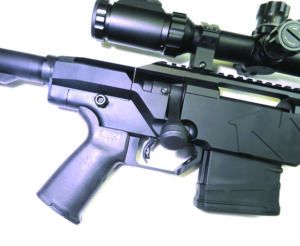
Test firing at 50, 100, and 200 yards was conducted sitting at a bench using our range bag as a rest and using a bipod. We used an old gym sock filled with sand for a toe bag. Sitting helped us get acquainted with the rifles. We also got our belly in the dirt and fired prone with both a bag and bipod. Shooting prone is the steadiest position you can shoot from, plus we were able to test the ergonomics of the rifles, such as comfort of the grip, access to the safety, ease in changing magazines, trigger consistency, access to scope turrets, stock comfort, ability to load a single round, etc.
Some of us just like to tickle steel at distance knowing we have the ability to read the wind and have a deep understanding of our equipment’s capabilities. Others like the juice of competition. We liked one of the three rifles the most, thinking it is competition ready out of the box, but is just as well suited for weekend shooters who like to go long. The other two rifles need some features before going muzzle to muzzle with competition-ready rifles. Here’s what else we found.
Gun Tests Grade: B+
$1509
The features you notice right away with the MVP are the Luth-AR MB-3 buttstock, 20-minute-of-angle (moa) Picatinny rail, M-Lok handguard, and a fully enclosed action with a straight-line stock design. With this set up, recoil travels straight back, allowing you to more easily stay on target and see hits.
| Action Type | Bolt, 2 lugs, 90-degree lift |
| Overall Length | 43.25 to 47.25 in. |
| Barrel | 24.0 in. long, medium bull, threaded |
| Twist Rate | 1:8 in. |
| Muzzle Device | None supplied |
| Sights | Optics ready, 20-MOA Picatinny rail |
| Overall Height | 7.0 in. |
| Weight Unloaded | 10 lbs. |
| Weight Loaded | 11.3 lbs. |
| Capacity | 10 |
| Stock | Luth-AR MBA 3, aluminum chassis |
| Stock Length of Pull | Adjustable, 12.5 to 16.5 in. |
| Stock Drop at Comb | Adjustable |
| Stock Drop at Heel | Adjustable |
| Buttplate | Rubber |
| Grip | Magpul MOE+ |
| Action Finish | Matte black, hard anodized |
| Barrel Finish | Matte blue |
| Magazine Type | Detachable polymer box |
| Trigger Pull Weight | Adj., 2.25 to 5.0 lbs. |
| Safety | Manual thumb |
| Accuracy Guarantee | None stated |
| Warranty | 1-year limited |
| Telephone | (203) 230-5300 |
| Website | Mossberg.com |
| Made In | USA |
The aluminum chassis has the Picatinny rail built into the top, which we appreciated, especially when shooting at ranges 400 yards or more. That lift gives your scope more elevation. The handguard attaches to the chassis and free-floats the barrel. At the rear, a section of the chassis connects to an AR-15 buffer tube so any AR-15 style stock can be attached. We don’t know why you would want to swap out the Luth-AR MB-3 stock because it is a swell stock. That rear part of the chassis is bolted in place and held tight by a thumb screw. You need to loosen the screw to remove the stock and rear section of the chassis to remove the bolt. We found the thumb screw was a comfortable place to rest the thumb for a right-handed shooter when grasping the grip.
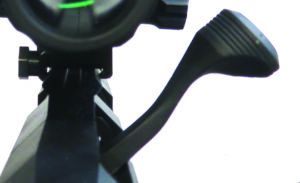
The Luth-AR MB-3 stock adjusts for length of pull, cheek-riser height, cast, and buttpad height. There’s also a rail section at the bottom for a monopod. Mossberg made a fine choice for a buttstock.
The trigger is Mossberg’s adjustable Lightning Bolt Action unit, which is excellent. It’s a blade-style trigger that broke clean and crisp at 2.6 pounds, which we thought was superb. The magazine release is set up similar to an AR-15 magazine release and is easy to operate with the trigger finger for a right-handed shooter. The safety, however, is set up like it was on a hunting rifle. It’s located on the right-hand side above the trigger and just aft of the bolt handle. It wasn’t the easiest safety to operate, and we needed to release our grip to flip it on and off.
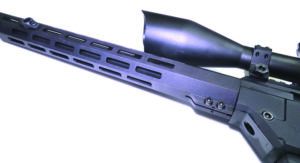
You may recall the MVP in 5.56 used a bolt head that has a small, hinged lever built into the bolt face that pushes the rear of the cartridge out of the AR-15 magazine. The 308 Winchester and 6.5 Creedmoor bolts are different. The bolts for these cartridges use a pair of tabs machined into the bolt head to push the cartridges out of AR-10 style magazines. The Mossberg ships with one 10-round Magpul PMag. The bolt knob is oversized and scalloped. We thought the edges on the bolt knob were a bit too sharp, and the bolt wasn’t as comfortable to operate as the others.
The 24-inch medium bull barrel is threaded and free-floated in a slim M-Lok rail. The rail is full of M-Lok slots placed at the usual 3, 6, and 9 o’clock positions, plus there are slots at 2, 5, 7, and 10 o’clock. There are a lot of mounting options for accessories like a bipod. You will need to purchase an M-Lok section of rail to mount that bipod. We would definitely invest in a muzzle brake, like the Precision Armament Hypertap Muzzle Brake ($179-$189; PrecisionArmament.com), and a seven- or nine-slot section of rail ($23-$24; Magpul.com). Or, if you prefer, any other muzzle brake or rail. By not adding these features to the MVP, Mossberg kept the cost down, but you will need to buy these parts to get full use out of the rifle.
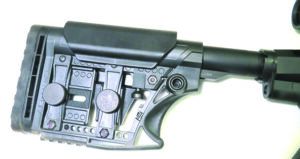
We mounted a UTG 4-16x44mm scope with a SFP 36-color Mil-Dot reticle and 30mm tube. This is an inexpensive optic, but it had the features you want out of the box, including medium-height rings, side parallax adjustment, tactical-style turrets with zero locking and zero resetting, and illuminated Mil-Dot reticle. The illumination can toggle between red, green, or black reticle, and it has the 36-color-mode feature, which can be useful, depending on the target color and background. For the cost, you can get into long-range shooting with this scope and not break the bank. We’ve used this scope on multiple rifles and calibers, and it still keeps ticking.
As we settled behind the MVP, we found the buttstock was willing to adjust to our stature and make shooting comfortable.
Our best group was well under a half-minute with the Prime 130-grain HPBT. It measured 0.29 inches. Marvelous. The best group with the SIG 140-grain OTM Match measured 0.67 inches. With the Hornady Match ammo loaded with a 140-grain ELD Match bullet, our best measured 1.09 inches. As we averaged the groups, we saw they measured 0.96 to 1.11 inches. Nice shooting. Loading single rounds was easy with the MVP. The ejection port was large enough to slip the round in and close the bolt. We thought the rifle was very comfortable to shoot, and we give props to the stock and trigger. It needs a muzzle brake to dampen recoil; we had a hard time seeing our hits on the HALO targets.
Our Team Said: The Mossberg provides a comfortable platform, but it does need a few accessories to make it better, namely a muzzle brake. At 10 pounds, it is fairly heavy, but we felt like it moved too much during recoil. Once you add the accessories, that should bulk up the weight. This is a good option, and the rifle delivers on getting you into long-range shooting at a low cost.
6.5 Creedmoor Range Data
To collect accuracy data, we fired three-shot groups from a bench using a rest. Distance: 100 yards. We recorded velocities using a ProChrono digital chronograph set 15 feet from the muzzle.| Hornady Match 140-grain ELD Match | Mossberg MVP Precision | Savage Axis II Precision | Ruger Custom Shop Precision Rifle |
| Average Velocity | 2766 fps | 2633 fps | 2700 fps |
| Muzzle Energy | 2379 ft.-lbs. | 2155 ft.-lbs. | 2267 ft.-lbs. |
| Smallest Group | 1.09 in. | 0.66 in. | 0.39 in. |
| Average Group | 1.11 in. | 0.67 in. | 0.56 in. |
| Prime 130-grain HPBT | Mossberg MVP Precision | Savage Axis II Precision | Ruger Custom Shop Precision Rifle |
| Average Velocity | 2777 fps | 2678 fps | 2781 fps |
| Muzzle Energy | 2226 ft.-lbs. | 2071 ft.-lbs. | 2233 ft.-lbs. |
| Smallest Group | 0.29 in. | 0.68 in. | 0.33 in. |
| Average Group | 1.09 in. | 0.80 in. | 0.53 in. |
| SIG Elite Performance 140-grain OTM Match | Mossberg MVP Precision | Savage Axis II Precision | Ruger Custom Shop Precision Rifle |
| Average Velocity | 2667 fps | 2580 fps | 2688 fps |
| Muzzle Energy | 2212 ft.-lbs. | 2070 ft.-lbs. | 2246 ft.-lbs. |
| Smallest Group | 0.67 in. | 0.28 in. | 0.18 in. |
| Average Group | 0.96 in. | 0.65 in. | 0.50 in. |
Value Guide: Short-Action Bolt Rifles
| Gun Name | Issue | Grade | Comments |
|---|---|---|---|
| CVA Cascade SB CR3914R 300 Blackout, $621 | Mar. 2022 | B+ | Our Pick. Most accurate of the three rifles tested, the CVA Cascade handles well and shoots well. |
| Savage Axis II 18819 300 Blackout, $385 | Mar. 2022 | B | Best Buy. While not as accurate as its Model 10 and 110 brothers, this Axis II performed well. |
| Ruger American Ranch Rifle 26968 300 Blackout, $529 | Mar. 2022 | C+ | Short and handy, but the action was rough initially. We graded it down for its mediocre accuracy. |
| Tikka T3X Varmint JRTXH312 223 Rem., $999 | Nov. 2021 | A | Our Pick. The most accurate rifle and perhaps the most versatile, we’d buy the Tikka T3X Varmint. |
| CZ Model 527 03019 223 Rem., $785 | Nov. 2021 | B+ | The trim receiver allowed the longest barrel, while maintaining a compact OAL. Outstanding trigger. |
| Ruger Hawkeye Predator 17122 223 Rem., $1359 | Nov. 2021 | B+ | A brushed stainless finish, a gorgeous three-color laminate stock, and a great trigger. |
| CVA Cascade CR3907C 350 Legend, $658 | Jul. 2021 | A | Our Pick. Outstanding trigger and tons of features on a value rifle. Tied with the Savage M110 Hog Hunter. |
| Masterpiece Arms MPA BA MPR PRO 6mm CM, $2499 | Apr. 2021 | A | Our Pick. A heavy, yet graceful beast of a rifle. The MPA is one of the most popular rifles on the PRS tour. |
| Christensen Arms MPR 801-03035-01 6mm CM, $1799 | Apr. 2021 | A- | Lightest sample included in this group, tested for a sport that prefers heavy rifles, and it still almost won. |
| Ruger Precision Rifle 18032 6mm CM, $1599 | Apr. 2021 | B+ | Good accuracy and dependability. We would have liked a crisper trigger and a wide, flat fore end. |
| Savage M110 Elite Precision 57558 6mm CM, $1999 | Apr. 2021 | B+ | Least accurate with the Federal ammo. Black Hills and Berger ammunition were much better. |
| Savage Arms 110 Hog Hunter 223 Rem., $599 | Feb. 2021 | A- | Oversized bolt, adjustable iron sights, adjustable LOP, a box magazine, and a threaded barrel. |
| Christensen Arms Ridgeline 801-06015-00 6.5 PRC, $1793 | Jan. 2021 | A | Our Pick. Accurate with factory ammunition — even better with reloads. Carryover winner from Nov. 2020. |
| Seekins Precision Havak Pro Hunter 2 0011710059-F 6.5 PRC, $1895 | Jan. 2021 | A | Outstanding accuracy with this round. We loved the stock and the trigger. |
| W’by Mark V Backcountry 6.5 RPM, $2249 | Jan. 2021 | B+ | Beautifully put together, but downrange accuracy wasn’t up to what we saw with other rifles. |
| Bergara Premier M’tn 2.0 BPR28-65PRC 6.5 PRC, $1999 | Nov. 2020 | A | A 100% carbon-fiber stock and trim 24-inch barrel make this a premier mountain rifle. |
| Browning X-Bolt Max LR 035438294 6.5 PRC, $1180 | Nov. 2020 | A | A little longer and a little heavier than our other test rifles. Beanfield rifle rather than a mountain rifle. |
| Savage M110 Hog Hunter 57534 350 Legend, $487 | Jul. 2020 | A | Our Pick. Compact size with a short, stiff, accurate barrel and a great trigger. Straight-wall chambering. |
| Ruger American Ranch Rifle 26985 350 Legend, $442 | Jul. 2020 | F/B+ | First sample failed when the bolt disassembled itself. The replacement rifle wasn’t all that accurate. |
| Winchester XPR Hunter 535741296 350 Legend, $635 | Jul. 2020 | A- | A full-length rifle that looked great and handled well; dropped off half a grade for its just-average accuracy. |




























Thanks for a very thorough article. I wish I had read it before purchasing! The Ruger Precision Rifle I was looking at sold, so I went with the Mossberg MVP Precision Elite (not sure if the Elite was the model you tested?). I had also considered the Sig Cross STX, but wanted to stay under $2K; wasn’t tracking the Savage, as it’s under 24″. I like that Mossberg left the muzzle break off, as most shooters have a preference or may want a suppressor.
I had a question on the ammunition used in the test. Were those the only 3 tested, or just the best 3? I ordered some Hornady 143gr and am wishing (from your article) that I’d Sig Elite. Looking forward to trying out the MVP!
Sincerely,
David Lloyd